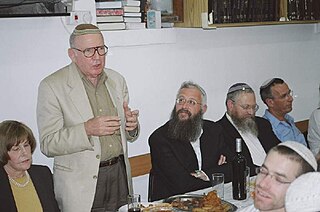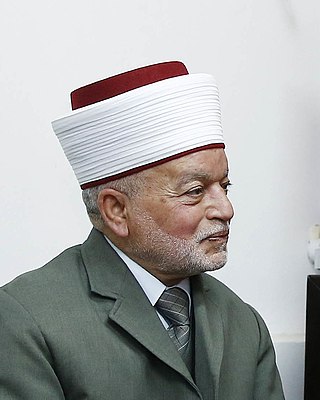| Shepherd Hotel | |
|---|---|
 | |
 | |
| General information | |
| Coordinates | 31°47′36″N35°14′02″E / 31.7933°N 35.2339°E |
The Shepherd Hotel was a hotel in the Sheikh Jarrah neighborhood of East Jerusalem.
| Shepherd Hotel | |
|---|---|
 | |
 | |
| General information | |
| Coordinates | 31°47′36″N35°14′02″E / 31.7933°N 35.2339°E |
The Shepherd Hotel was a hotel in the Sheikh Jarrah neighborhood of East Jerusalem.
The building was built in the 1930s by Baruch Katinka, a Jewish engineer and partner in the Albina Katinka Dunia construction company. It was commissioned as a home for the Muslim Mufti of Jerusalem, Haj Amin al-Husseini, who never lived there. [1] The mufti transferred the right to live there to his personal secretary, George Antonius and his wife Katy, who were local celebrities and hosted parties and social gatherings there. [2] After Antonius died in 1942, his widow continued to reside in the house and became involved romantically with the commander of the British forces in Palestine, Evelyn Barker. [1]

In early 1947, Katy Antonius left the house after a nearby building was blown up by the Irgun, which claimed it tried to warn her but her telephone was constantly busy. After the establishment of the State of Israel, the building was taken over by the Hashemite Kingdom of Jordan and reopened as a hotel for pilgrims. A new wing was added which obscured the original architecture. [1]
Following the Six-Day War, Israel occupied East Jerusalem and the hotel was declared "absentee property" (AP) and became the property of the Government of Israel under the "Absentee Property Law". It was used by the Ministry of Justice and as a district courthouse. [3]
The land use of the building is part of Plan 2591 approved in 1982 by the Jerusalem District Committee of the Interior Ministry, and is designated for residential use.
The Custodian of Arab Property sold the building and surrounding land in 1985 to Irving Moskowitz, a Jewish-American businessman, supporter of Israeli settlers activities in East Jerusalem, who renamed it the "Sheffer Hotel." [1] At the beginning of the first Intifada in 1987, the Border Police leased the building and stayed there for about 15 years before moving to their new building alongside Highway One.

Following the zoning of Plan 2591, a request was made on November 6, 2008 to permit construction by C and M Properties Ltd. of two new residential buildings, which include 20 apartments, underground parking, flat roofs, and two floors above the parking level.
In March 2009, the project appeared on the agenda of the licensing committee of the Jerusalem Municipality but was removed later. But on July 2, 2009, at the height of U.S. efforts to press Israel to adopt a settlement freeze in order to get the peace process going, the Local Planning Committee of the Jerusalem Municipality approved the request, which included the destruction of the existing buildings on the property, except for the historic structure designated for preservation. The U.S. government voiced its displeasure over the project to Israel's Washington ambassador in 2009 after the plan received the green light from the Municipality, a direct challenge to President Barack Obama's effort to launch negotiations toward Israeli–Palestinian and Israeli–Arab peace.
Construction was delayed for six months due to a dispute with a son of Faisal al-Husseini, a former Palestinian Authority minister for Jerusalem affairs, who claimed that the family owned part of the parking lot. The court rejected this claim. Demolition began on January 9, 2011. [4]
The Israeli Supreme Court ruled in February 2012 that the Husseini family could not claim ownership of the landmark because too much time had passed since Israeli authorities had transferred the property to private developers. [5]
The new building is the first settlement construction in Sheikh Jarrah since 1967.

Mohammed Amin al-Husseini was a Palestinian Arab nationalist and Muslim leader in Mandatory Palestine. Al-Husseini was the scion of the al-Husayni family of Jerusalemite Arab nobles, who trace their origins to the Islamic Prophet Muhammad.

Faisal Abdel Qader Al-Husseini was a Palestinian politician.

Fawzi al-Qawuqji was a Lebanese-born Arab nationalist military figure in the interwar period. He served briefly in Palestine in 1936 fighting the British Mandatory suppression of the Palestinian Revolt. A political decision by the British enabled him to flee the country in 1937. He was a colonel in the Nazi Wehrmacht during World War II, and served as the Arab Liberation Army (ALA) field commander during the 1948 Palestine War.

Husayni is the name of a prominent Palestinian Arab clan formerly based in Jerusalem, which claims descent from Husayn ibn Ali.

Silwan or Siloam is a predominantly Palestinian district in East Jerusalem, on the southeastern outskirts of the current Old City of Jerusalem.

Mamilla Cemetery, sometimes called Ma'aman Allah Cemetery, is a historic Muslim cemetery in West Jerusalem that dates back to the Crusades, and lies just to the west of the north-west corner of the walls of the Old City of Jerusalem, near the New Gate. The cemetery, at the center of which lies the Mamilla Pool, contains the remains of figures from the early Islamic period, several Sufi shrines and Mamluk-era tombs. The cemetery grounds also contain the bodies of thousands of Christians killed in the pre-Islamic era, as well as several tombs from the time of the Crusades.
Icon of Evil: Hitler's Mufti and the Rise of Radical Islam is a 2008 book by David G. Dalin and John F. Rothmann initially published by Random House; the 2009 version of the book by Transaction Publishers has an introduction by Alan Dershowitz. It is a biography of Haj Amin al-Husseini (1895–1974), who was the Grand Mufti of Jerusalem during the British Mandate period. Some reviewers were critical of its "overtly propagandistic" style, citing numerous factual errors and criticizing its thesis that a direct line can be drawn from the Mufti to modern-day Islamic leaders as unconvincing and lacking evidence. Other reviewers praised the book, one describing it as "the first serious biography of the mufti to appear in 14 years".

Sheikh Jarrah is a predominantly Palestinian neighborhood in East Jerusalem, two kilometres north of the Old City, on the road to Mount Scopus. It received its name from the 13th-century tomb of Hussam al-Din al-Jarrahi, a physician of Saladin, located within its vicinity. The modern neighborhood was founded in 1865 and gradually became a residential center of Jerusalem's Muslim elite, particularly the al-Husayni family. After the 1948 Arab–Israeli War, it became under Jordanian-held East Jerusalem, bordering the no-man's land area with Israeli-held West Jerusalem until Israel occupied the neighborhood in the 1967 Six-Day War. Most of its present Palestinian population is said to come from refugees expelled from Jerusalem's Talbiya neighbourhood in 1948.

Irving Moskowitz was an American physician, businessman, and activist. His activism, in part, sought to create a Jewish majority in Palestinian Arab neighborhoods of East Jerusalem by purchasing land.

Shimon HaTzadik is an Israeli settlement in East Jerusalem, established around the Tomb of Simeon the Just, after whom it was named. The neighborhood was established in 1890 and abandoned during the 1948 Palestine war. At the beginning of the new millennium after a long legal battle, Jewish residents settled down in the area near the Arab neighborhood of Sheikh Jarrah.
Operation Atlas was the code name for an operation carried out by a special commando unit of the Waffen SS which took place in October 1944. It involved five soldiers: three who were previously members of the Templer religious sect in Mandatory Palestine, and two Palestinian Arabs who were close collaborators of the mufti of Jerusalem, Amin al-Husseini.

Nahalat Shimon was a Jewish religious neighborhood of about 40 Jewish families in East Jerusalem in the area currently known as Sheikh Jarrah. It was founded in 1891 by Sephardic and Ashkenazi Jewish Kollels, to house poor Yemenite and Sephardi Jews. The cornerstone of the neighborhood was laid in 1890, near the Tomb of Simeon the Just.

The London Conference of 1939, or St James's Palace Conference, which took place between 7 February – 17 March 1939, was called by the British Government to plan the future governance of Palestine and an end of the Mandate. It opened on 7 February 1939 in St James's Palace after which the Colonial Secretary, Malcolm MacDonald held a series of separate meetings with the Arab Higher Committee and Zionist delegation, because the Arab Higher Committee delegation refused to sit in the same room as the Zionist delegation. When MacDonald first announced the proposed conference he made clear that if no agreement was reached the government would impose a solution. The process came to an end after five and a half weeks with the British announcing proposals which were later published as the 1939 White Paper.

The Grand Mufti of Jerusalem is the Sunni Muslim cleric in charge of Jerusalem's Islamic holy places, including Al-Aqsa. The position was created by the British military government led by Ronald Storrs in 1918. Since 2006, the position has been held by Muhammad Ahmad Hussein, appointed by the Palestinian President, Mahmoud Abbas.
This is a timeline of intercommunal conflict in Mandatory Palestine.

Al-Quds University is a public university in the Jerusalem Governorate, Palestine. The main campus is located in Abu Dis town, near Jerusalem, with three more such campus in Jerusalem and other campuses in Ramallah and Hebron. It was established in 1984, by merger of more local institutions in Jerusalem.

The Sheikh Jarrah controversy, which has been described as a "property/real estate dispute" by the Israeli government and its supporters, and as an "expulsion", "displacement" or "ethnic cleansing" event and a matter of international law by Palestinians and their supporters, is a long-running legal and political dispute between Palestinians and Israelis over the ownership of certain properties and housing units in Sheikh Jarrah, East Jerusalem. The evictions are considered a contributory cause of the 2021 Israel–Palestine crisis.

Palestinian displacement in East Jerusalem is the transfer of Palestinian residents from the city due to Israeli policies aimed at an Israeli-Jewish demographic majority. Many Palestinian families in East Jerusalem have been affected by "forced relocation processes or been involved in lengthy legal procedures to revoke an eviction order." According to the United Nations Office for the Coordination of Humanitarian Affairs (OCHA), between a third to a half of East Jerusalem's houses do not have permits, potentially placing over 100,000 Palestinian residents of the city at risk of forced displacement and forcible transfer as a result of demolitions.

Al-Bustan is a well-watered area and neighbourhood located to the south of Wadi Hilweh in the Silwan area of East Jerusalem, and currently consists of more than 100 Palestinian homes. The area is the subject of a controversial proposed Israeli development project that envisions demolishing the existing houses and creating a national park, while constructing new four-story apartment buildings around it into which the current residents would be relocated.

The Palace Hotel was a historic hotel built across from the Mamilla Pool in Jerusalem by the Supreme Muslim Council. The hotel opened in 1929 and is now the Waldorf-Astoria Jerusalem.